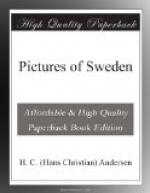She sat still in a corner by the window, wrapped up in herself, and staring before her, as if she were a figure that had flown out of the frame around the dark, mouldy canvas, which had once shown a picture on the wall.
Here, in the room, in this impure atmosphere, the old man lived happily, and reached his seventieth year, occupied with the translation of travels in Africa. This tainted atmosphere, in which he lay, became, to his conceit, the dromedary’s high back, which lifted him aloft in the burning sun; the long, hanging-down cobwebs were the palm-trees’ waving banners, and the caravan went over rivers to the wild bushmen. Old Oedmann was with the hunters, chasing the elephants in the midst of the thick reeds; the agile tiger-cat sprang past, and the serpents shone like garlands around the boughs of the trees: there was excitement, there was danger—and yet he lay so comfortably in his good and beloved bed in Upsala.
One winter’s day, it happened that a Dalecarlian peasant mistook the house, and came into Oedmann’s chamber in his snow-covered skin cloak, and with his beard full of ice. Oedmann shouted to him to go his way, but the peasant was deaf, and therefore stepped quite close up to the bed. He was the personification of Winter himself, and Oedmann fell ill from this visit: it was his only sickness during the many years he lay here as a polypus, grown fast, and where he was painted, as we see his portrait in the assembly-room.
From the hall of learning we will go to its burial-place—that is to say, its open burial-place—the great library. We wander from hall to hall, up stairs and down stairs. Along the shelves, behind them and round about, stand books, those petrifactions of the mind, which might again be vivified by spirit. Here lives a kind-hearted and mild old man, the librarian, Professor Schroeder. He smiles and nods as he hears how memory’s sprite takes his place here as guide, and tells of and shows, as we see, Tegner’s copy and translation of Ochlenschloeger’s “Hakon Jarl and Palnatoke.” We see Vadstene cloister’s library, in thick hog’s leather bindings, and think of the fair hands of the nuns that have borne them, the pious, mild eyes that conjured the spirit out of the dead letters. Here is the celebrated Codex Argentius, the translation of the “Four Evangelists."[Q] Gold and silver letters glisten from the red parchment leaves. We see ancient Icelandic manuscripts, from de la Gardie’s refined French saloon, and Thauberg’s Japanese manuscripts.




